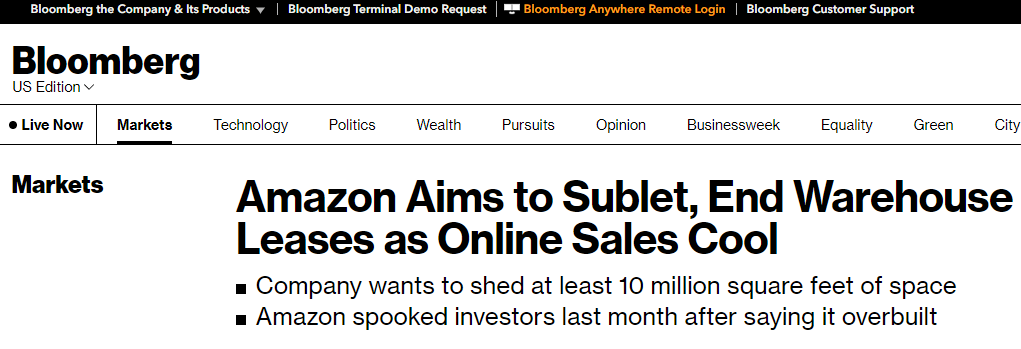Thanks to a surge in online shopping during the pandemic, Amazon leased 370 million square feet of industrial space in its home market, double the amount two years ago.
However, according to its latest financial report, due to the gradual relaxation of the current epidemic control measures and the fading of the online shopping tide driven by the new crown epidemic, the company's growth has slowed down and its profit outlook has been weak. The extra space is expected to cost $10 billion in additional costs in the first half of this year.
Severe oversupply of warehousing
Amazon to end multiple warehouse leases
Amazon has been suffering from over-capacity warehouses in recent times, so the company is considering subleasing at least 10 million square feet of space and possibly terminating the lease, according to people familiar with the matter.

It is reported that Amazon’s current warehouse locations with excess storage capacity are located in New York, New Jersey, Southern California and Atlanta, and the excess space may be far more than 10 million square feet, and may even be three times that number, but the final assessment number has not yet been estimated. Sure.
In the future, Amazon may try to negotiate termination of leases with existing landlords, including industrial real estate developer Prologis Inc., which counts the e-commerce giant as its largest tenant.
In order to avoid reducing too much storage space at once, the company plans to sublease the 10 million square feet, which is equivalent to about 5% of the storage space that Amazon has increased during the epidemic, and some sublease lease terms are only one to one, according to people familiar with the matter. two years in order to prepare for a rapid rebound in online shopping demand.
In response, Amazon declined to say which venues it plans to sublease or to confirm the sublease amount.
Amazon cuts hiring plans
Excessive Expansion During Pandemic Excessive Excess
Since the outbreak of the epidemic, Amazon's online retailing pace has continued to increase, securing its top spot in the global online retailing market. During the period from 2020 to 2022, in order to meet the needs of the global online market, Amazon continues to expand, and has established large-scale logistics distribution centers in various places to speed up the delivery of goods.
According to statistics, Amazon's logistics and distribution centers have provided hundreds of thousands of jobs.
In the second half of 2021 alone, Amazon added 270,000 jobs. But by 2022, Amazon has encountered a crisis of labor overcapacity due to the unhappy online market. The labor glut increases Amazon's labor costs, cutting into the company's profits.
Amazon Chief Financial Officer Brian Olsavsky said the reduction in productivity cost Amazon about $2 billion, resulting in a net loss of $3.8 billion in the first quarter, its first quarterly loss since 2015.
As growth slows and various costs rise, Amazon's retail business is cutting its external hiring targets, and the number of hires will be lower than previously planned.
According to reports, Gokul Dakshina, Amazon’s vice president of finance, sent an email to the team, saying that with limited resources, the team needs to make prioritization adjustments.
Some Amazon units have cut hiring targets by 7 percent, a person familiar with the matter said.
A separate email leaked last month showed that Amazon's "Global Consumer Business" had cut its hiring for this year by 1,511. This unit is responsible for Amazon's online store, warehouse distribution and logistics.
A person familiar with the matter said the hiring cuts were mostly for the company's annual salaried functional employees rather than hourly wage warehouse workers.
An Amazon spokesman did not comment on the report. The slowdown in external hiring, however, is the latest sign of a slowdown in Amazon's overall business.
In addition, as Prime Day is approaching, some freight forwarders recently said that Amazon warehouses have reappeared.
Multiple Amazon warehouses burst
Delivery appointment will be delayed
According to reports from multiple sellers, they have received notices from cooperative freight forwarders: Amazon LGB8, ONT8, and LAX9 have been out of stock, and the delivery appointment will be delayed by about 1-2 weeks. At the same time, the SMF3 warehouse is being renovated, and the appointment of SMF3 will be delayed until June. The four warehouses mentioned above are all located in the western United States.
Many sellers said that the recent slowdown in the listing speed may be related to the explosion of several warehouses.
According to the freight forwarder, the appointment time of most warehouses is currently adjusted to early June. If the appointment in early June is not delayed, it is expected to return to normal in early June. Due to irresistible reasons, please sellers and friends adjust the stocking plan and delivery time.
Although the United States has serious inflation now, the willingness of American consumers to spend has continued unabated.
Container imports at the top 10 U.S. ports rose 7 percent in April from a year earlier to 2,189,744 TEUs, according to U.S. consulting firm Blue Alpha Capital. Among them, the Port of Long Beach handled 820,718 TEUs of cargo in April, a year-on-year increase of 10%.
Mario Cordero, executive director of the Port of Long Beach, said: "Cargo volumes continue to grow at record rates and may not slow down anytime soon, and we are preparing for a possible surge in transportation demand over the summer."
According to previous official news, this year's Prime Day is scheduled to be held in July. Based on the current growth in consumer demand, Amazon sellers can also look forward to this year's Prime Day.
Previous:Here's everything you need to know about organic search (Part 2)
Next:Amazon stops hiding its own brands, U.S. economy shrank 1.5% in first quarter